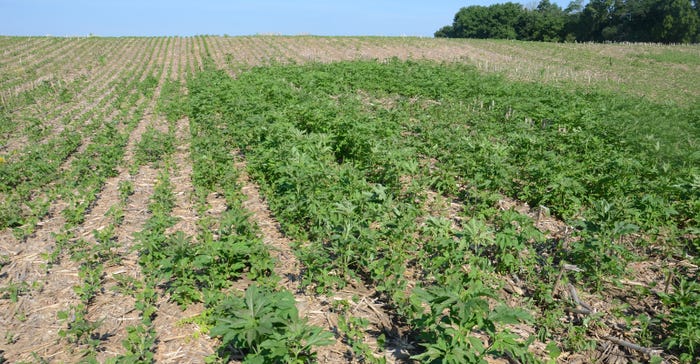
They call it giant ragweed for a reason. If you take your foot off the gas and giant ragweed lurks in the field, you could end up with a giant, out-of-control mess.
Bill Johnson, Purdue University Extension weed control specialist, says the secret is taking command early, planting into a clean field, and spraying postemergence applications to control what you couldn’t get with residual herbicides, especially in soybeans. There are more tools available in the residual herbicide toolkit for corn than soybeans, he notes.
Johnson assists weed control specialists in Ohio and Illinois in preparing the Weed Control Guide for Ohio, Indiana and Illinois. The 2022 edition is available and includes a section on controlling giant ragweed.
Grab control
Here are tips from the guide for taking control over giant ragweed:
Corn. A clean start is critical, Johnson says. If you’re no-tilling, a preplant application of 2,4-D ester plus atrazine should knock out emerged plants. Consider adding Gramoxone 3.0 SL if plants are large.
“A combination of preemergence followed by postemergence herbicides provides the most effective giant ragweed control,” Johnson says. It can help tame fields where giant ragweed won before.
Start with atrazine and add Acuron, Lumax, Lexar or similar herbicides, or begin with atrazine and add SureStart/TripleFlex, Balance Flexx, Corvus or Verdict/Sharpen.
Many postemergence corn herbicides control giant ragweed, especially if they contain atrazine or dicamba. If glyphosate performed poorly on giant ragweed before, and hybrids are glyphosate tolerant, include another herbicide with glyphosate, and make the rate high enough to control glyphosate-resistant ragweed. Candidates for tankmixes include Status, Impact/Armezon, mesotrione products, Laudis and dicamba.
In LibertyLink corn, control escapes with glufosinate, which is Liberty, or glufosinate plus atrazine.
Soybeans. If not tilling, clean up existing plants before planting with 2,4-D ester, or 2,4-D ester plus glyphosate or Gramoxone on taller giant ragweed plants. If you can’t use 2,4-D, apply Sharpen, Optill Pro or Verdict plus glyphosate or glufosinate, or apply glufosinate and metribuzin. Johnson also recommends applying residual herbicides with chorimuron or cloransulam, Scepter, or Alite 27. Note that Alite 27 requires GT27 soybeans.
“You might get by with one post application if the burndown and residual work well or if the giant ragweed population is low,” Johnson says. “However, if you have a moderate to dense population, expect to need a second application to get late emergers.”

In non-GMO soybeans, FirstRate or fomesafen, or FirstRate plus fomesafen, provides consistent results unless ragweed plants are resistant to FirstRate.
In Roundup Ready soybeans, apply glyphosate when ragweed are 6 to 10 inches tall. Use the higher recommended rate where control failed before. Spray again three to four weeks later to knock out remaining plants.
“If it’s beans after beans or you’ve had trouble with giant ragweed, a second application is essential,” Johnson says.
If ragweed is glyphosate resistant, spray glufosinate (if you can get it) in glufosinate-tolerant soybeans, dicamba for dicamba-tolerant soybeans, or 2,4-D choline for Enlist soybeans. You will likely need a second application to control escapes. In Xtend and XtendFlex beans, that may mean switching to a Group 14 herbicide if it’s after the cutoff date for spraying dicamba.
About the Author(s)
You May Also Like




